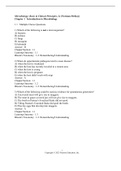Exam (elaborations)
Test Bank for Microbiology 2nd Edition Norman McKay| Chapter 1 - 21 Updated Guide
- Course
- Institution
- Book
Microbiology 2nd Edition Norman McKay Test Bank Test Bank for Microbiology 2nd Edition Norman McKay Chapter 1 - 21 Updated Guide
[Show more]



